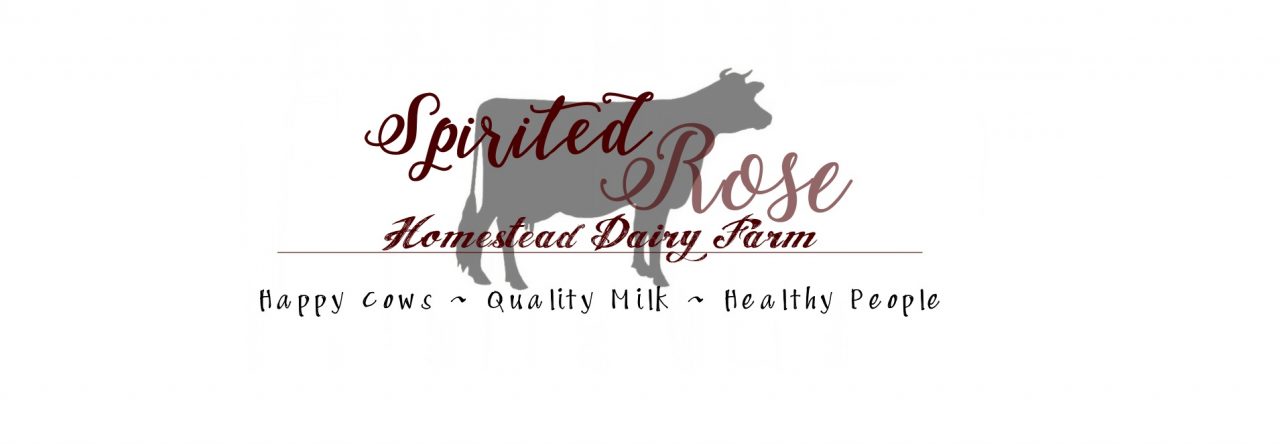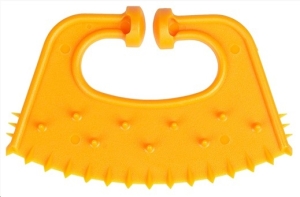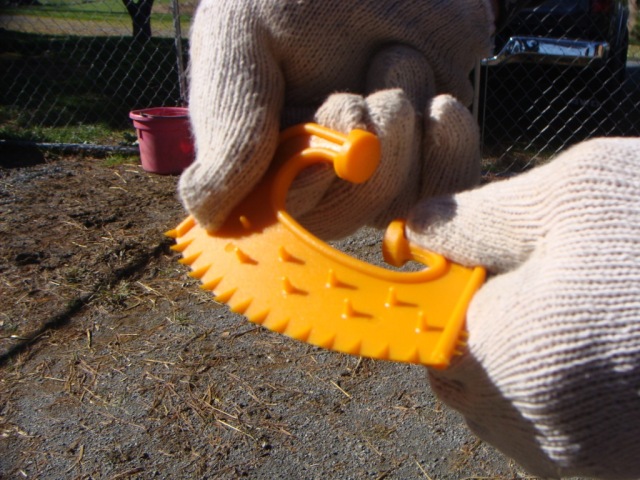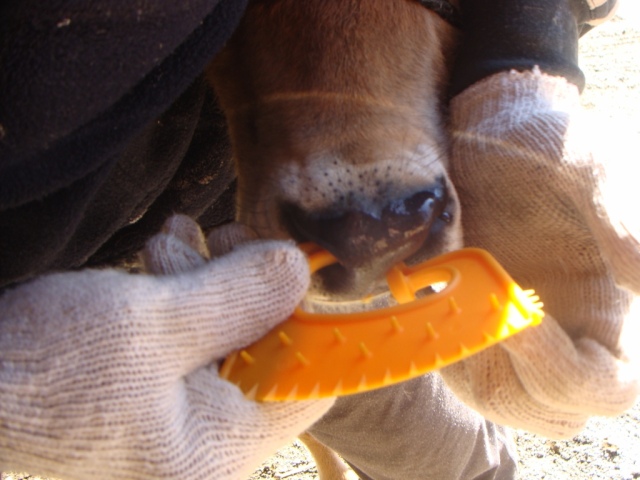Updated October 2015
WHAT THEY ARE:
Weaning rings are used for the purpose of preventing a bovine from sucking (sucking on other calves, weaning from mother cow, etc.)
Weaning rings come in a variety of shapes, sizes, and abilities. Most are a type that you insert and tighten down with a screw… But the screw often come loose and fall off! We have had good luck with the plastic weaning rings that are inserted easily (non-permanent) and come out easily. Some have had luck with Quiet Wean style plastic weaning rings, but persistent calves are more likely to find a way to nurse around this style of weaner.
WHO CAN WEAR ONE?
Usually, a weaning ring is applied to a young bovine for the purpose of preventing them from sucking. This sucking can be on other heifers or on cows of any stage of lactation/dry. The particular weaning ring we use fits on small calves all the way up to young cows (persistent suckers!) There are many styles and shapes, so feel free to research which style best fits your needs.
WHY IS SUCKING BAD?
- First, non-milking animals have a natural plug in each teat. Sucking softens the tissue and causes the teat to unplug, allowing in potentially pathogenic bacteria.
- Second, sucking on another heifer’s teats or udder area (also referred to as “udder promise”) can lead to tissue damage or mastitis.
- Tissue damage is often not noticeable, until the heifer calves and becomes a cow. Severe tissue damage creates a “blind quarter” – which is a quarter that creates no milk ever. It usually looks much smaller, because it does not stretch out with milk secreting tissue (hence the name “blind”). Less severe damage may result in odd lumps, reduced production, etc.
- Mastitis will often tend to be noticeable (redness, heat, swelling, hardness) and can occur to bred or unbred, milking or dry animals. If noticed in a non-milking animal, mastitis should still be properly treated and milked out to flush out the infected material.
HOW TO APPLY:
2. Insert on one side of nose, then push toward the other side with the ring as you pull the nose toward you.
3. Wiggle up and down to make sure the ring is in securely
FOLLOW UP:
The calf may act a little dizzy after you put on the weaning ring. They seem to stare at it so hard they can fall over! Don’t worry, they will soon figure it out!
They may also not eat much the first day. NOT because they are in pain, but because they are learning how to adapt to eating around the weaning ring.
Are the pokeys on the weaning ring necessary? Other people have tried using the “quiet wean” which is similar to this weaning ring, but with no pokeys. That leaves no deterrent to the sucker or suckee, and they can work around the weaning ring to continue nursing. Some have used them successfully, so there’s no harm in giving it a try and changing to a different style if that one does not work.
HOW LONG TO KEEP THEM IN:
If the calf in with other heifers: you can leave the weaning ring in for a week to a month and then take it out and see how they do. If they start sucking again, you can put the weaning ring back in for a longer period of time. Every animal is different! 🙂
If you are keeping a weaned calf with the mother: you will need to keep the weaning ring in for a long time, maybe until they are a cow! (Note, long term use can cause callouses inside the nose, that will go away over time once the weaner is removed.)
We advocate fence line weaning or separation –
- Putting the newly weaned calf in a pen next to the mother, so they can still see each other but the calf cannot suck. No need for a weaning ring at all in this situation.
- Or, totally removing the calf so they cannot see each other. This method is more effective when separating at birth.






We have some yearling Jersey heifers that we have used these on, they work wonderfully… Saves the Heifers from getting ruined by getting nursed on before they ever even lactate… People that live in the City or Subdivision Homes, y’all worse then Locust… Save the Farmland, Save the Climate, Save the Earth…
LikeLike
Wow, this amazing! Do you sell them for human babies?
LikeLiked by 1 person
WHAT IS WRONG WITH YOU PEOPLE? EVIL! I WISH WE COULD TEACH CHILDREN IN SCHOOL AT A YOUNG AGE HOW THEIR ANIMAL FOOD IS SOURCED, I GUARANTEE YOU EVERY ONE WOULD BECOME A VEGAN!
LikeLiked by 1 person
Parents pierce the ears of young children, without their consent.
In mild contrast, this weaning ring style does not pierce anything, it’s a simple piece of plastic. 🙂
LikeLike
Parents piercing their young’s ears is completely different than being unable to suck milk.
LikeLike
Yet both young do get weaned. Keep in mind, calves are only given a weaning ring on occasion when they’re not supposed to be sucking milk, such as sucking on the teats of another heifer (that can ruin her future udder) or when a cow needs to go dry in order to have a rest before she calves again, so that her colostrum is fresh and healthy for her new calf. I prefer separation over use of a weaning ring when at all possible, though in some cases separating animals is not practical.
LikeLike
I spotted the vegan. Too easy. 😂
LikeLike
I take it you still breast feed. Your poor mother…
LikeLike
Thank you! I appreciate your reply and advice. Here’s hoping it all works out and Merry Christmas!
LikeLike
Thanks for the info. Is there any way for me to know if damage has already been done? I don’t see any redness or swelling or anything that would indicate a problem. Thanks again, I still have lots to learn and it’s so helpful to learn from experience!
LikeLike
You won’t see anything unless mastitis is present – then you would see normal signs of infection. Just check occasionally by looking at it. If she’s nice, you could scratch her rump and just check the teat area in general to watch for lumps or hardness.
As far as permanent damage, you wouldn’t know until she calved in. Almost all heifers calve in with four working quarters, but if you keep notes on your animals, you might just put a little note next to her breeding records or health records that says “Dec 2014, sheep tried to nurse heifer” Then if she calved in with a shy quarter, you’d have the records to remember what might have caused it. Records are helpful, we’re more forgetful than we think, I think! 🙂
LikeLike
Can I use these on a sheep who seems to think that my heifer is a 2nd mother?
LikeLike
No, I would think this brand would be too large. The nobs that go into the nose probably wouldn’t even fit into a sheep’s little nose.
I would suggest moving the heifer, at least into a separate pen so they can’t nurse her – dry-nursing a heifer can easily lead to mastitis or a ruined (“dry”) quarter.
LikeLike
I was really disappointed because these seemed like such a good idea! But 50% of my calves learned to wean around the non-spiked ones in a matter of a day or so, and the others followed suit after seeing the first ones learn to nurse sideways. Switched to the spiked ones with a similar outcome. Within 4 days the entire herd was back to nursing… at which point I gave up and removed them. If they were made then a bit longer and maybe slightly curved on the sides, I think that could be prevented.
LikeLike
Flip the spikes inward toward the nose. Really agressive calves may require this.
I’d also suggest trying to limit opportunity. Maybe smaller pens or separating non-suckers from those more persistent.
I’m not sure what your raising methods are, but you can also try other things to limit sucking such as teaching dairy calves to drink from a bucket (as opposed to nipple) at a younger age. As calves, we try to keep them far enough apart that they can’t reach each other to suck.
For beef, maybe letting the calves nurse longer and letting the mothers self-wean would help? We’ve never had problems with our beef, but the calves also stay with their moms and the moms self wean and there’s no stress.
LikeLike
I would like to ask you : I use weaning rings – the round ones with the pokeys. They are only about 50% effective in my herd as the calves learn to flip them up onto their noses and suck sideways. Do you have any ideas on how to modify these rings in order to stop this?
LikeLike
Worst case scenario, you can flip the weaning ring upside down and try again (so the pokeys are towards the nose). that makes it harder to flip up. Has worked for some.
Some suck sideways no matter what, so you could put something bitter or hot (pepper spray?) on what they are sucking. If it’s other animals, then the only way I know to get it to stop is to separate them completely for a month or more, then re-introduce them and see if after all that time of not sucking, if they’ve given up the habit. Works for most. 🙂
LikeLike
use weanpro calf weaning rings, they can’t flip them up
http://www.weanpro.com.au
LikeLike
Some people have difficulty keeping the screws tight…how does yours stay put after adjustment?
LikeLike
Could you please let me know how to get 3 and the cost.thank you eugene
LikeLike
They’re around $2 from http://www.valleyvet.com/ct_detail.html?pgguid=30e07afe-7b6a-11d5-a192-00b0d0204ae5&gas=wean
I see Nasco offers them now too!
LikeLike
What a great idea. And you show just how to put it in and where to buy.
LikeLike